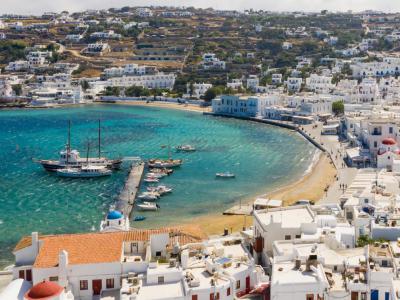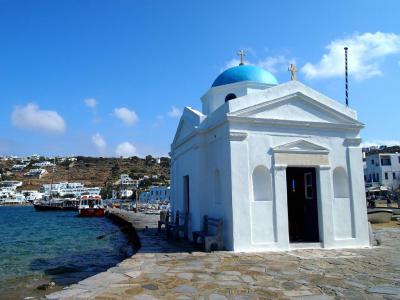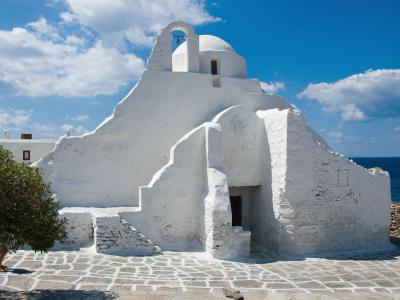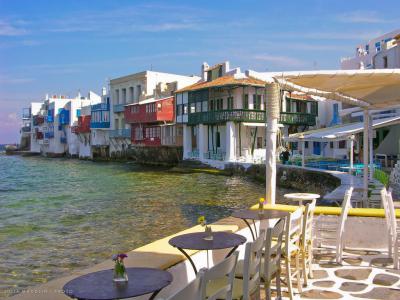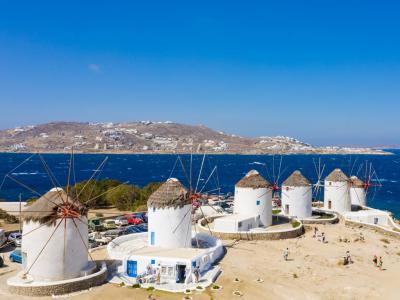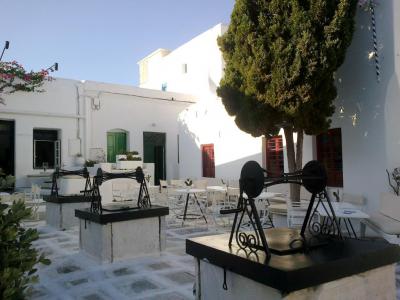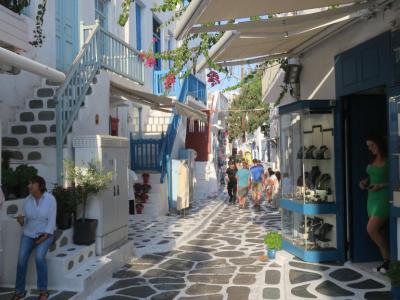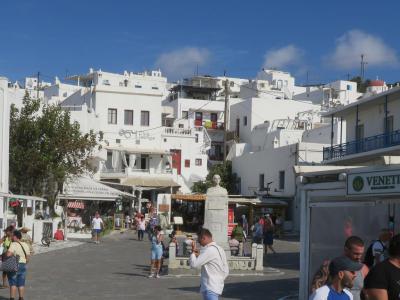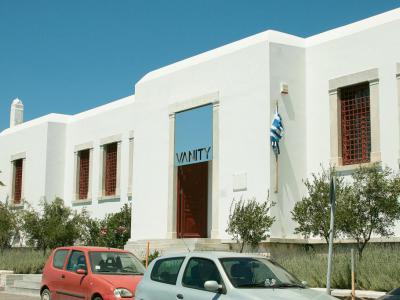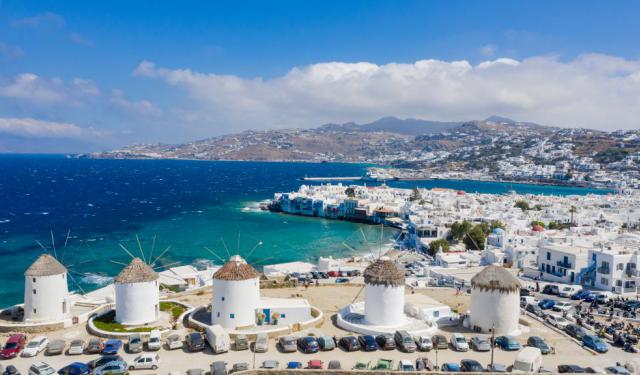
Mykonos Introduction Walking Tour (Self Guided), Mykonos
Mykonos is both an island and a city in Greece. The island of Mykonos is part of the Cyclades. It is known for its beautiful beaches and an active nightlife. The city of Mykonos, often referred to as the Chora, is where most of the island's residents work and live.
The history of Mykonos dates to at least the 11th century BCE. It was under Roman control through the 12th century when the Byzantine Empire took over the island. In 1390, Mykonos fell under Venetian rule. Artifacts from each of these time periods have been uncovered and are on display at the Archaeological Museum of Mykonos.
Tourism has been an essential industry in Mykonos since the mid-20th century. By the 1980s, the island became known as a popular tourist destination with the LGBTQ+ community due to its gay-friendly atmosphere.
Visitors to Mykonos will spend much of their time on the stunning beaches. Paradise Beach, Super Paradise Beach, and Elia Beach are three of the most popular beaches on the island. They are busy throughout the day with a party-style atmosphere in the late afternoon and evening. A quieter beach is Kalafati Beach, which never gets very crowded but still offers soft sand and blue waters.
Along with beaches, tourists will also find several shopping areas, churches, and notable places that are sure to catch their eyes. Manto Mavrogenous Square is a great place for tourists to get acquainted with the city's restaurants, shops, and historical spots.
Must-see churches in Mykonos include the Saint Nicholas Church and the Church of Panagia Paraportiani. Every visitor to Mykonos must stop to get a picture of the famous Mykonos Windmills. They might even be able to go inside one of the windmills that are open to the public.
Take this self-guided walking tour to see the beauty and majesty of Mykonos.
The history of Mykonos dates to at least the 11th century BCE. It was under Roman control through the 12th century when the Byzantine Empire took over the island. In 1390, Mykonos fell under Venetian rule. Artifacts from each of these time periods have been uncovered and are on display at the Archaeological Museum of Mykonos.
Tourism has been an essential industry in Mykonos since the mid-20th century. By the 1980s, the island became known as a popular tourist destination with the LGBTQ+ community due to its gay-friendly atmosphere.
Visitors to Mykonos will spend much of their time on the stunning beaches. Paradise Beach, Super Paradise Beach, and Elia Beach are three of the most popular beaches on the island. They are busy throughout the day with a party-style atmosphere in the late afternoon and evening. A quieter beach is Kalafati Beach, which never gets very crowded but still offers soft sand and blue waters.
Along with beaches, tourists will also find several shopping areas, churches, and notable places that are sure to catch their eyes. Manto Mavrogenous Square is a great place for tourists to get acquainted with the city's restaurants, shops, and historical spots.
Must-see churches in Mykonos include the Saint Nicholas Church and the Church of Panagia Paraportiani. Every visitor to Mykonos must stop to get a picture of the famous Mykonos Windmills. They might even be able to go inside one of the windmills that are open to the public.
Take this self-guided walking tour to see the beauty and majesty of Mykonos.
How it works: Download the app "GPSmyCity: Walks in 1K+ Cities" from Apple App Store or Google Play Store to your mobile phone or tablet. The app turns your mobile device into a personal tour guide and its built-in GPS navigation functions guide you from one tour stop to next. The app works offline, so no data plan is needed when traveling abroad.
Mykonos Introduction Walking Tour Map
Guide Name: Mykonos Introduction Walking Tour
Guide Location: Greece » Mykonos (See other walking tours in Mykonos)
Guide Type: Self-guided Walking Tour (Sightseeing)
# of Attractions: 9
Tour Duration: 1 Hour(s)
Travel Distance: 1.5 Km or 0.9 Miles
Author: nataly
Sight(s) Featured in This Guide:
Guide Location: Greece » Mykonos (See other walking tours in Mykonos)
Guide Type: Self-guided Walking Tour (Sightseeing)
# of Attractions: 9
Tour Duration: 1 Hour(s)
Travel Distance: 1.5 Km or 0.9 Miles
Author: nataly
Sight(s) Featured in This Guide:
- Old Port
- Saint Nicholas Church
- Church of Panagia Paraportiani
- Little Venice
- Mykonos Windmills
- Three Wells
- Matoyianni Street
- Manto Mavrogenous Square
- Archaeological Museum of Mykonos
1) Old Port (must see)
The Old Port of Mykonos, also known as the Venetian Port, has been an important hub of trade and commerce in the Aegean Sea for centuries. In fact, it was one of the most important ports in the Mediterranean during the 18th and 19th centuries, when it served as a crucial stop for merchant ships travelling between Europe, Asia, and the Middle East.
The Old Port was built in the 16th century by the Venetians, who ruled the island at the time, and it was strategically located on the western side of Mykonos, sheltered from the strong winds that often batter the island. The port's unique design, with its distinctive semi-circle shape, allowed for easy mooring and loading of goods, making it a popular spot for traders and merchants.
Today the Old Port is a spectacular place to wander while touring the island on foot. Visitors will find charming shops, restaurants, and hotels throughout the Old Port area.
Visitors can walk along the pier to gaze at the blue waters of the Aegean Sea. Because most vessels now use New Port, the Old Port is mainly calm except for some private boats and yachts.
The Old Port neighborhood offers some lovely buildings and visitor attractions. Visitors will see churches like the Holy Temple of the Unwithering Rose, Saint Nicholas Church, and the Church of St. Basil. They will also find the Archaeological Museum of Mykonos. The museum offers art and artifacts dating to the 25th century BCE.
Visitors enjoy wandering the picturesque alleys in the area around the Old Port. They are quiet and serene while also providing a glimpse into daily life on Mykonos.
The Old Port was built in the 16th century by the Venetians, who ruled the island at the time, and it was strategically located on the western side of Mykonos, sheltered from the strong winds that often batter the island. The port's unique design, with its distinctive semi-circle shape, allowed for easy mooring and loading of goods, making it a popular spot for traders and merchants.
Today the Old Port is a spectacular place to wander while touring the island on foot. Visitors will find charming shops, restaurants, and hotels throughout the Old Port area.
Visitors can walk along the pier to gaze at the blue waters of the Aegean Sea. Because most vessels now use New Port, the Old Port is mainly calm except for some private boats and yachts.
The Old Port neighborhood offers some lovely buildings and visitor attractions. Visitors will see churches like the Holy Temple of the Unwithering Rose, Saint Nicholas Church, and the Church of St. Basil. They will also find the Archaeological Museum of Mykonos. The museum offers art and artifacts dating to the 25th century BCE.
Visitors enjoy wandering the picturesque alleys in the area around the Old Port. They are quiet and serene while also providing a glimpse into daily life on Mykonos.
2) Saint Nicholas Church
The Saint Nicholas Church is a small Greek Orthodox church near the Old Port. It is also known as the Chapel of Saint Nicholas or Agios Nikolaos Church.
The church is dedicated to Saint Nicholas, the patron saint of sailors, fishermen, and travelers. It is a long-held belief that Saint Nicholas visited the island around 500 AD to celebrate his saint day. Locals believe he has been visiting the island every year ever since. They also claim to see him helping protection to those navigating water. The Saint Nicholas memory is celebrated every December 6th with a litany of his icon along the coast and a huge feast and various festivities.
The Saint Nicholas church was built in the 4th century. Its design is that of Cycladic traditional architecture, featuring a picturesque white building with a blue dome, blue doors and windows, and blue, slatted benches, all together being in harmony with the homes and businesses in Mykonos.
The church's interior is simple, with icons of the Apostles and the Virgin Mary. Candles are available to anyone who would like to light one in reverence.
The church is dedicated to Saint Nicholas, the patron saint of sailors, fishermen, and travelers. It is a long-held belief that Saint Nicholas visited the island around 500 AD to celebrate his saint day. Locals believe he has been visiting the island every year ever since. They also claim to see him helping protection to those navigating water. The Saint Nicholas memory is celebrated every December 6th with a litany of his icon along the coast and a huge feast and various festivities.
The Saint Nicholas church was built in the 4th century. Its design is that of Cycladic traditional architecture, featuring a picturesque white building with a blue dome, blue doors and windows, and blue, slatted benches, all together being in harmony with the homes and businesses in Mykonos.
The church's interior is simple, with icons of the Apostles and the Virgin Mary. Candles are available to anyone who would like to light one in reverence.
3) Church of Panagia Paraportiani (must see)
The Church of Panagia Paraportiani is one of the most beautiful churches on the island of Mykonos, located in the Kastro neighborhood of Chora, the name called by locals. Overlooking the Aegean Sea, the church impresses with its unique architectural style and history behind its construction.
Panagia Paraportiani means "Our Lady of the Side Gate" (or Virgin Mary Standing Next to the Entrance Door) in Greek and has its entrance at the side gate of the Kastro neighborhood.
What makes this church so unique is its construction - an asymmetrical conglomeration of 5 churches, built gradually over the centuries. The churches dedicated to Saint Efstathios, Saint Anargyros, Saint Sozon, and Saint Anastasia are at the ground level and made the foundation of the fifth church, Panagia Paraportiani.
Some sources show that the first church, Saint Anargyros, began in 1425. Others state that the church was completed in the late 1300s. What is known is that the final church, the Church of the Virgin Mary, was completed during the 17th century.
The church features a Cycladic architectural style with whitewashed walls, minimal aesthetics, a daring style, and smooth-edged corners. A large dome that dominates the building nearly merges with the roof. The absence of external decorations and unusual shape made the church notable.
The Church of Panagia Paraportiani, one of the most recognizable and photographed churches on the island, has been declared a national monument.
Panagia Paraportiani means "Our Lady of the Side Gate" (or Virgin Mary Standing Next to the Entrance Door) in Greek and has its entrance at the side gate of the Kastro neighborhood.
What makes this church so unique is its construction - an asymmetrical conglomeration of 5 churches, built gradually over the centuries. The churches dedicated to Saint Efstathios, Saint Anargyros, Saint Sozon, and Saint Anastasia are at the ground level and made the foundation of the fifth church, Panagia Paraportiani.
Some sources show that the first church, Saint Anargyros, began in 1425. Others state that the church was completed in the late 1300s. What is known is that the final church, the Church of the Virgin Mary, was completed during the 17th century.
The church features a Cycladic architectural style with whitewashed walls, minimal aesthetics, a daring style, and smooth-edged corners. A large dome that dominates the building nearly merges with the roof. The absence of external decorations and unusual shape made the church notable.
The Church of Panagia Paraportiani, one of the most recognizable and photographed churches on the island, has been declared a national monument.
4) Little Venice (must see)
Little Venice is one of the top tourist attractions in Mykonos. Located in Chora, Little Venice sits on the waterfront, overlooking the Aegean Sea. The area was first named Alefkandra due to its proximity to the picturesque Alefkandra beach.
Unlike most buildings in Greece that utilize the bright, whitewashed Cycladic architecture, many of the homes in Little Venice are vibrant and colorful. They have adopted traditional Venetian architecture, noticed in the arches and wooden balconies.
Venetian influence began in the 13th century when the island was part of the Venetian trade route. Mykonos was often the spot where sailors would stop to rest and dine. This practice continued through the 18th century.
Today, Little Venice is a hotbed of activity. There are numerous shops, bars, clubs, and cafes, that populate the area. It is usually busy during the day but becomes a party-like atmosphere at night. Visitors will enjoy music and bright lights while partying with tourists and locals.
Tourists who want to experience a calmer atmosphere should plan a morning in Little Venice. There are plenty of historical sights to see, like Mykonos Castle, the Mykonos Folklore Museum, the Church of Saint Nicholas, and the Church of Panagia Paraportiani.
To the southwest of Little Venice, just north of the Mykonos Windmills, is a perfect viewing spot. Tourists should plan to bring a camera to capture Little Venice from a distance either before or after enjoying the food, drinks, shopping, and other activities in this picturesque neighborhood.
Unlike most buildings in Greece that utilize the bright, whitewashed Cycladic architecture, many of the homes in Little Venice are vibrant and colorful. They have adopted traditional Venetian architecture, noticed in the arches and wooden balconies.
Venetian influence began in the 13th century when the island was part of the Venetian trade route. Mykonos was often the spot where sailors would stop to rest and dine. This practice continued through the 18th century.
Today, Little Venice is a hotbed of activity. There are numerous shops, bars, clubs, and cafes, that populate the area. It is usually busy during the day but becomes a party-like atmosphere at night. Visitors will enjoy music and bright lights while partying with tourists and locals.
Tourists who want to experience a calmer atmosphere should plan a morning in Little Venice. There are plenty of historical sights to see, like Mykonos Castle, the Mykonos Folklore Museum, the Church of Saint Nicholas, and the Church of Panagia Paraportiani.
To the southwest of Little Venice, just north of the Mykonos Windmills, is a perfect viewing spot. Tourists should plan to bring a camera to capture Little Venice from a distance either before or after enjoying the food, drinks, shopping, and other activities in this picturesque neighborhood.
5) Mykonos Windmills (must see)
The Mykonos Windmills, or Kato Mili, are arguably the most noteworthy and recognizable sight in all of Mykonos. Due to their location and size, the Mykonos Windmills can be seen from every point of the town.
The windmills stand on a hill near Alefkandra Harbor. Most windmills face north, taking advantage of the strong northerly winds. There were once 28 windmills throughout the island. Today, there are 16 in total in Mykonos. Seven windmills stand over the harbor on the landmark hill in Chora.
The traditional Cycladic style windmills are heavy three-story constructions made of stone, with a spherical shape, small windows, and a pointed roof made of the finest wood. They are painted snow-white to blend in with the rest of the island's buildings.
The Venetians began building windmills in the 16th century. Built to mill wheat, they have been an essential source of income for the locals. Construction on the mills continued through the early 20th century.
By the mid-20th century, the use of mills gradually decreased since electricity became a more widespread and reliable way to mill wheat and barley.
Most of the windmills have been renovated to serve new purposes. Some are used as houses, while others function as storage. One of the windmills is now a museum. All of them are important reminders of the past.
Two of the windmills of Mykonos, located near the harbor, can be toured. The Geronymos Mill is the oldest operated since the 1960s. Its original grinding equipment has been restored and is on full display.
The second windmill open to the public is Bonis Mill, and it is part of the Mykonos Agricultural Museum. The mill and the museum are open from 4 PM to 8 PM during the summer. A festival takes place at this mill each September. It celebrates the past with food, drink, music, dancing, and traditional storytelling.
The windmills stand on a hill near Alefkandra Harbor. Most windmills face north, taking advantage of the strong northerly winds. There were once 28 windmills throughout the island. Today, there are 16 in total in Mykonos. Seven windmills stand over the harbor on the landmark hill in Chora.
The traditional Cycladic style windmills are heavy three-story constructions made of stone, with a spherical shape, small windows, and a pointed roof made of the finest wood. They are painted snow-white to blend in with the rest of the island's buildings.
The Venetians began building windmills in the 16th century. Built to mill wheat, they have been an essential source of income for the locals. Construction on the mills continued through the early 20th century.
By the mid-20th century, the use of mills gradually decreased since electricity became a more widespread and reliable way to mill wheat and barley.
Most of the windmills have been renovated to serve new purposes. Some are used as houses, while others function as storage. One of the windmills is now a museum. All of them are important reminders of the past.
Two of the windmills of Mykonos, located near the harbor, can be toured. The Geronymos Mill is the oldest operated since the 1960s. Its original grinding equipment has been restored and is on full display.
The second windmill open to the public is Bonis Mill, and it is part of the Mykonos Agricultural Museum. The mill and the museum are open from 4 PM to 8 PM during the summer. A festival takes place at this mill each September. It celebrates the past with food, drink, music, dancing, and traditional storytelling.
6) Three Wells
The Three Wells, also known as Tria Pigadia, are a trio of wells in Mykonos. They were built in 1722 to provide Chora, the island's main town, with water and were in use through 1956.
The three wells are identical. They were built in the sand to take advantage of the shallow ground. At less than 20 feet in depth, they are much shorter and smaller than traditional wells that are generally 100 feet deep or more.
Legend holds that anyone who drinks from the wells will soon marry. Another legend states that any tourist who drinks from the wells will fall in love with the island of Mykonos and will never want to leave.
The wells are located in a courtyard in the central part of the town, surrounded by museums, shopping boutiques, bars, and restaurants. Visitors to the wells should also look for the I Love Mykonos staircase, only a few steps away.
The three wells are identical. They were built in the sand to take advantage of the shallow ground. At less than 20 feet in depth, they are much shorter and smaller than traditional wells that are generally 100 feet deep or more.
Legend holds that anyone who drinks from the wells will soon marry. Another legend states that any tourist who drinks from the wells will fall in love with the island of Mykonos and will never want to leave.
The wells are located in a courtyard in the central part of the town, surrounded by museums, shopping boutiques, bars, and restaurants. Visitors to the wells should also look for the I Love Mykonos staircase, only a few steps away.
7) Matoyianni Street (must see)
Matoyianni Street is a lively street in the heart of the island that travels through the town of Mykonos. A heaven for shopaholics, the area is populated with designer boutiques and souvenir shops. During the summer months, most of Matoyianna’s shops and markets are open until around midnight, and you will never be short of things to do throughout the evening.
The Matoyianni, short and narrow, runs between Kalogera Street and Enoplon Dinameon Street and is packed with things to see and do. Visitors can shop for clothing, shoes, and jewelry. The items most coveted by tourists are replicas of Byzantine-style jewelry and brightly colored sandals. Also, it is worthwhile to stop at Pantopoleion - a stunning 300-year-old Mykonian store selling a range of Greek organic foods, natural cosmetics, and local crafts.
The street houses restaurants ranging from ice cream to local cuisine. A famous bakery, Skaropoulos, has been in continuous operation for over 100 years. Cocktail bars and nightclubs are popular with tourists and locals, often playing music through the early morning hours.
The Matoyianni, short and narrow, runs between Kalogera Street and Enoplon Dinameon Street and is packed with things to see and do. Visitors can shop for clothing, shoes, and jewelry. The items most coveted by tourists are replicas of Byzantine-style jewelry and brightly colored sandals. Also, it is worthwhile to stop at Pantopoleion - a stunning 300-year-old Mykonian store selling a range of Greek organic foods, natural cosmetics, and local crafts.
The street houses restaurants ranging from ice cream to local cuisine. A famous bakery, Skaropoulos, has been in continuous operation for over 100 years. Cocktail bars and nightclubs are popular with tourists and locals, often playing music through the early morning hours.
8) Manto Mavrogenous Square
Manto Mavrogenous Square in the Old Port of Mykonos is usually bustling with activity, with numerous shops and cafes surrounding the cobbled pavement.
The square is dedicated to Manto Mavorgenous, the beautiful female commander of Mykonos who helped change the course of history in Greece. Magdalena "Manto" Mavrogenous was an aristocratic woman who donated all her money to fund the War of Independence in 1821. In addition, she led military expeditions and was credited with causing the Turks to retreat.
A memorial to Manto Mavrogenous is located in the heart of the square. A larger-than-life bust of her head rests upon a seven-foot-tall pedestal made from marble. It is surrounded by two-foot tall stone fencing that is short enough to allow visitors to pay tribute but doesn't allow them to come close enough to cause damage to the statue. The pedestal is inscribed with her name.
The square is dedicated to Manto Mavorgenous, the beautiful female commander of Mykonos who helped change the course of history in Greece. Magdalena "Manto" Mavrogenous was an aristocratic woman who donated all her money to fund the War of Independence in 1821. In addition, she led military expeditions and was credited with causing the Turks to retreat.
A memorial to Manto Mavrogenous is located in the heart of the square. A larger-than-life bust of her head rests upon a seven-foot-tall pedestal made from marble. It is surrounded by two-foot tall stone fencing that is short enough to allow visitors to pay tribute but doesn't allow them to come close enough to cause damage to the statue. The pedestal is inscribed with her name.
9) Archaeological Museum of Mykonos
The Archaeological Museum of Mykonos is one of the oldest museums in Greece, created to preserve artifacts from the Putrefaction Pit (a hole that contained numerous urns and vessels of offerings) of the islet of Rheneia, which dates back to 426-425 B.C.
The museum, built in 1905, was designed by famous architect Alexandros Lykakis in the Neoclassical architectural style. As the need for more space grew, the museum expanded. Its last expansion was in 1972.
The Archaeological Museum of Mykonos now includes items dating from the 9th century BCE. Items on display include pottery, grave markers, and statues.
The most famous item in the museum is arguably the pithos, or ancient pot, that shows scenes from the capture of Troy. It was unearthed in 1961. Another famous relic is the Archaic Hydria, a red floral vase, found in the Purification Pit. Also of note is a clay figurine of a woman in a Grecian tunic that dates to the 2nd century.
The museum, built in 1905, was designed by famous architect Alexandros Lykakis in the Neoclassical architectural style. As the need for more space grew, the museum expanded. Its last expansion was in 1972.
The Archaeological Museum of Mykonos now includes items dating from the 9th century BCE. Items on display include pottery, grave markers, and statues.
The most famous item in the museum is arguably the pithos, or ancient pot, that shows scenes from the capture of Troy. It was unearthed in 1961. Another famous relic is the Archaic Hydria, a red floral vase, found in the Purification Pit. Also of note is a clay figurine of a woman in a Grecian tunic that dates to the 2nd century.
The Most Popular Cities
/ view all
